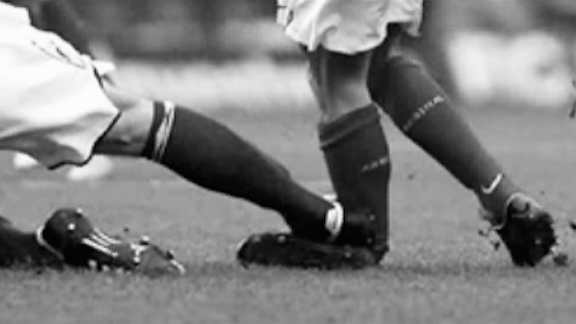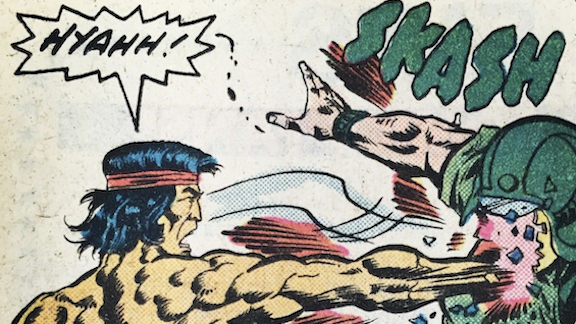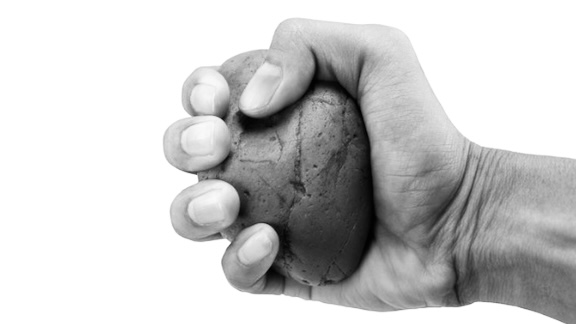
There is a baseline level of confusion about what exactly it is we do; confusion that I am, quite frankly, tired of hashing and rehashing. There are deep-seated biological, psychological, and societal reasons for this confusion—and so it is perfectly natural for it to persist—but as an instructor it frustrates me because treading back and forth across this well-worn rut doesn’t make you any better at doing violence.
The only thing that makes you better is getting the mechanics down pat—where and how to cause injury, and how to best take advantage of the results. Everything else is just mental masturbation that feels important because it tastes like philosophy with a little bit of work mixed in. You think you’re working—while avoiding doing any of the real work that will make you better at violence, namely getting a reaction partner and hitting the mats regularly.
And so I am going to flog a dead horse again today, but my goal is to flay it to the bone (or finally sell it off if you take the original meaning); I want to take it to its absurd, logical conclusion beyond which there is no more jaw-flapping:
What we teach is violence, which is what you need to do when someone wants to murder you.
So where’s the confusion? That seems pretty clear-cut. And that’s what I think, too. But then the questions start:
Why would I ever need to know how to kill someone?
Won’t I get in trouble if I use this in a bar fight?
But what if he’s got X and/or Y and he’s coming at me like so?
How do I do it to someone who knows what you know?
What if he does it first?
Or one of the other infinite facets of the question that tells me you don’t really believe that bigger-faster-stronger doesn’t matter. You want to believe, but you don’t.
Where does all this confusion come from? It arises because you think you know what you’re seeing, but you’re looking at it through the wrong mental porthole. When fists and feet are flying, you see monkey politics. You see competition. It’s all great apes working out dominance and submission. Don’t feel bad—you’re hardwired to recognize and respond to this. It’s only natural. Which is why I want to start the violence conversation off with one person shooting another person to death.
Watching one person kill another with a firearm won’t ping your monkey brain. It’ll go far deeper, down into the lizard-level, the primeval predator level. You’ll see it for what it is: killing. If we look at the underlying mechanics, we have:
kinetic energy delivered through anatomy, wrecking it
And now we have the perfect model to work backwards from. Keep the killing context, keep the wrecked anatomy in mind, and now look at other ways of causing that outcome. A fist, a boot, a pipe, a shin, etc., etc.—it doesn’t matter what as long as it’s doing the work that a bullet does, if only in a generic sense. So now if we line up a series of killings and look at them side-by-side—a shooting, a stabbing, a bludgeoning, getting hit by a car—we should be able to see the clear, underlying principles that govern all of these equally and immutably. Learning how to wield these principles is “getting the mechanics down pat” I mentioned earlier.
All clear, right? No—back to the confusion: you get the gun and the car, but you feel iffy about the pipe and the knife, and downright scoff at the fist, boot, or shin.
Why?
Because you read it with your monkey politics filter and think there’s something you can do about it. “I can’t dodge bullets, but I can block a punch.” This is the ultimate in hubris and sends you down a negative feedback spiral: If you can “handle” a punch, then of course they can “handle” it when you’re trying to do it to them. You’re pissing in your confidence reservoir and your training will look hesitant and spotty. And that’s exactly where your skill will go. You’re thinking that you’re fighting when we really want you doing something completely else.
We are trying to teach you how to kill murderers. Everything that fits that narrow model benefits you. Anything that sounds out of place or silly in that context is useless.
That’s why “murder” is the final word in context. Almost no one knows what to do when that’s what’s up. “Fighting” and “defense” are worthless in that arena—remember that defense wounds are found on corpses and tell the coroner that the person “fought for their life.” You’re not going to fight anyone for your life. You’re going to kill a murderer.
Armed with this new context, let’s look at the common questions:
Why would I ever need to know how to kill someone?
If that someone is a murderer, then ipso facto. It’s like asking, “If drowning can kill me, why train to swim in water?”
Won’t I get in trouble if I use this in a bar fight?
Yes. Yes, you will.
But what if he’s got X and/or Y and he’s coming at me like so?
Would you ask the same question with a gun or a steering wheel in your hand? Of course you laugh, but a crushed throat and a gouged eye don’t care if it was bullets, hood ornaments, or boots that did it. So why should you?
How do I do it to someone who knows what you know?
Injured is injured, dead is dead, regardless of talent or training.
What if he does it first?
Then you have nothing to worry about.
Bigger-faster-stronger?
The murderer doesn’t care—in fact, that’s one reason why he’s successful. And that should inform your thinking on the subject.
Here’s the bottom line: check yourself and stick with what matters. Is your question, your doubt, your worry rooted in the mechanics of injury or is it stuck in monkey politics, in “fighting”? Be honest with yourself. If it’s the mechanics, we can work on that, show you what to do and how to do it. After that it’s on you to hit the mats with a partner and take ownership of it. If it’s competition, monkey politics, or has anything to do with communication or changing behavior, then it’s immaterial and meaningless in the context of killing a murderer.
Because you don’t talk to, try to best, or even fight with murderers. You kill them.
— Chris Ranck-Buhr (from 2006)











